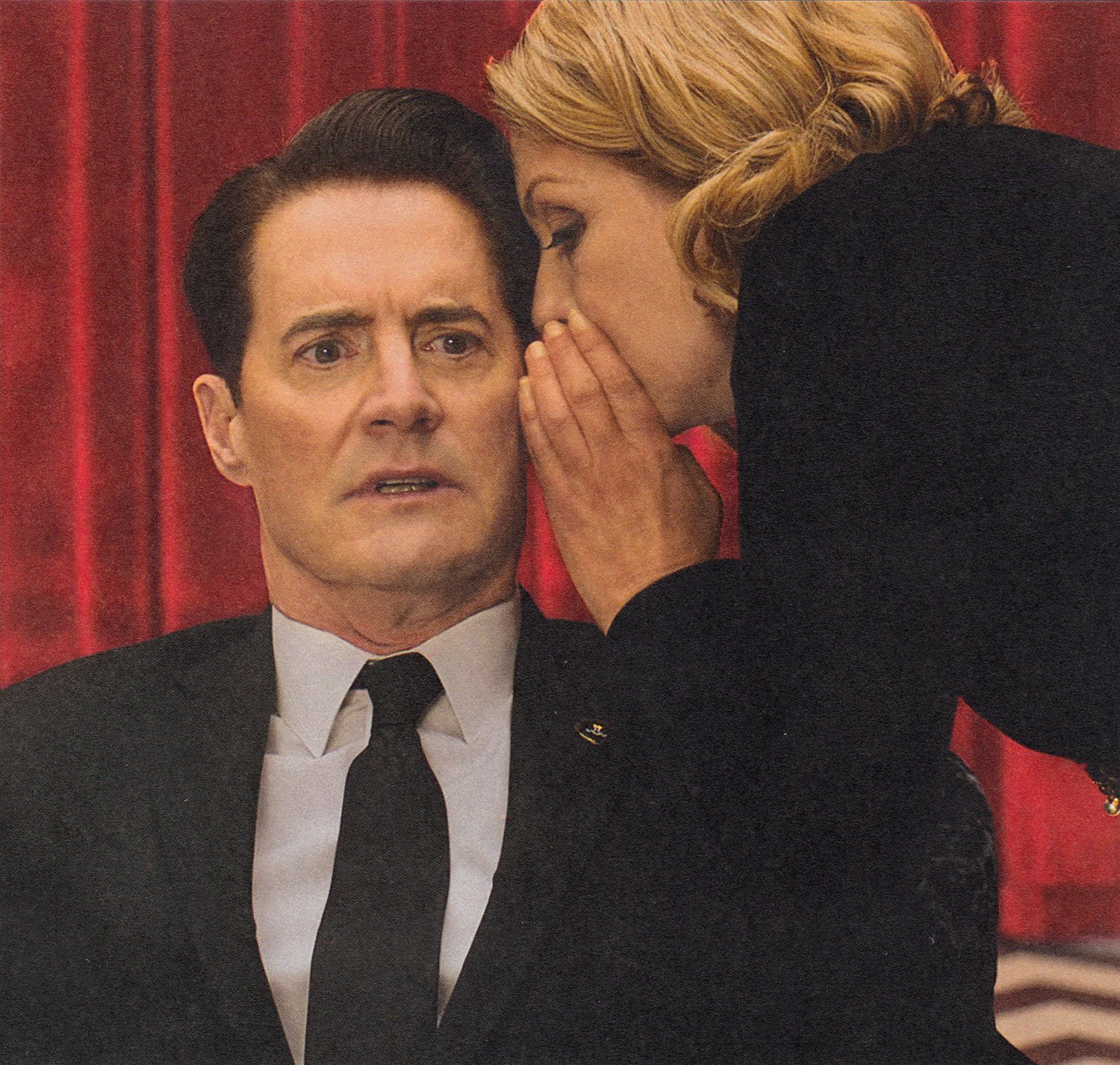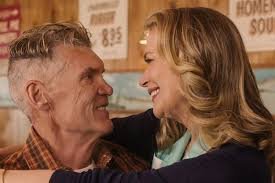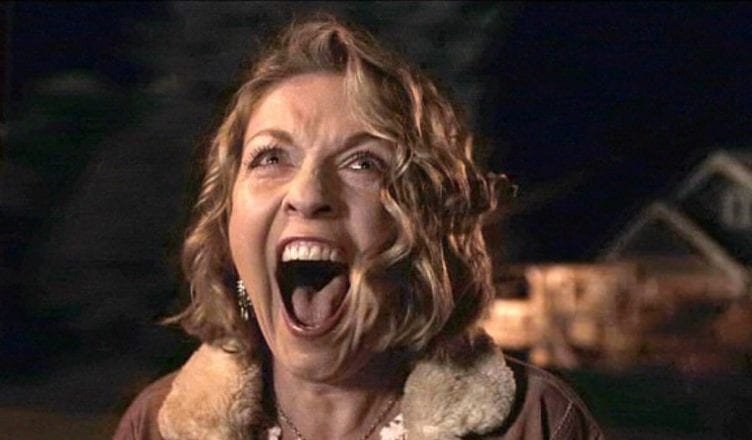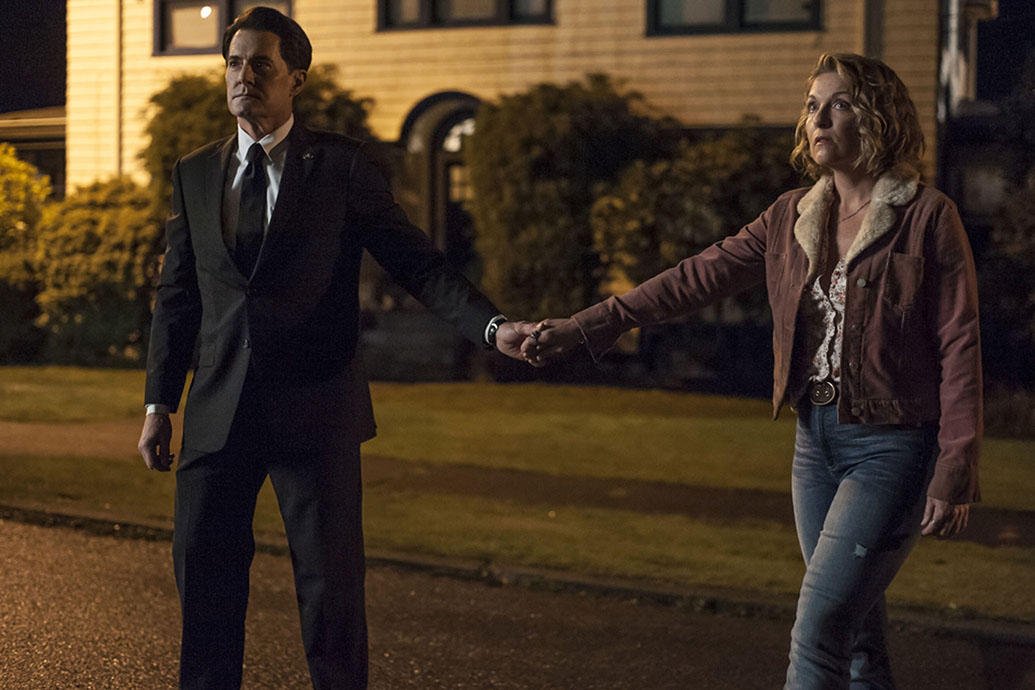THE RETURN/NO RETURN (Parts 9-18): David Lynch's Summation (so far) by Craig Hammill
This is the fourth and final part of a four part series looking at David Lynch’s & Mark Frost’s 45+ hour masterwork TWIN PEAKS which comprises two network television seasons that ran on ABC from 1990-1991 (Part 1), a 1992 feature film and scenes cut out from that feature (Part 2), a 2017 limited Showtime series Lynch considers a feature film in 18 parts of which we discussed Parts 1 - 8 (Part 3), and now discuss Parts 9-18 (Part 4), today. The previous three parts can be found between July-September 2023 on this blog.
“Do I contradict myself? Very well then I contradict myself, (I am large, I contain multitudes.)” - Walt Whitman Song of Myself 51
After the stunning sui generis hour of television, filmmaking that is Part 8 of TWIN PEAKS: THE RETURN, any vestigial notions audience members had that they knew where David Lynch’s and Mark Frost’s Season 3/18 hour feature was going were blown to smithereens.
Even in a career resolutely committed to surprising his audience, David Lynch held the Part 8 ace up his sleeve and played it as both a master filmmaker and a master showman.
Part 8, with its extended black and white flashback to 1945, the explosion of the first atom bomb, its trip to a new transcendental citadel where good and evil appear to be created, monitored, wrestled with, felt like such a climax/summation, it was hard to figure out exactly where Parts 9 through 18 could go. Or match up.
What’s stunning, in retrospect, is the dual structure of the show. As with all the doubling, dopplegangers, tulpas, repeated phrases, twins, contrasts, rhymes in THE RETURN, the structure itself is a double, rhyme contrast. Parts 1-8 build to a first climax (Part 8). Parts 9-18 build to a second climax (Parts 17 & 18). Parts 8 & 18 even speak to each other (through the repeated use of the Platters song “My Prayer”).
As many have pointed out, doubling is in the title of the show itself: TWIN PEAKS.
And just as nothing could prepare us for Part 8, nothing could prepare us for the stunning risk and left turn that would become Parts 17 & Part 18.
Parts 9 through 17 do return us to the general structure of the overall feature. We pick up with all the storylines-Dougie, Bill Hastings, the Twin Peaks Sheriff’s department, etc-and get introduced to a few remaining new stories, most notably the long awaited appearance of Audrey Horne (Sherilyn Fenn) in Part 12 though, in keeping with defying expectation, Audrey appears stuck in some kind of Kafkaesque nightmare of thwarted dream logic in either a mental health institution or a coma.
The back end of THE RETURN also grows richer, sadder, more profound in its overall consideration of aging and death. This is extremely powerful in the story of the Log Lady (Catherine Caulson). As was mentioned before, Caulson, who had worked with Lynch since ERASERHEAD and even helped fund that movie with her waitress’ tips, was in hospice care in Ashland, Oregon when it came time to shoot her scenes. Lynch directed Caulson by zoom so she could do all her scenes without having to leave her home. And though I can’t say this with certainty, it seems probable that Caulson and Lynch agreed to weave in Caulson’s own approaching death into the Log Lady’s scenes. These scenes are all touching conversations between the Log Lady calling from her home and Deputy Sheriff Hawk (Michael Horse) who always takes the calls at the Twin Peaks Sheriff’s station. Throughout the RETURN, the Log Lady, as she did in the original TV series, gives cryptic clues. But this time, there is an unbearable joyful beauty and deep sadness to the Log Lady. She makes comments like “the glow is fading” in earlier parts. Then in her final call (Part 15), she says several towering optimistic things “My log is turning to gold” and “Death is not an end, it’s only a change” before near wailing “I’m dying Hawk.” If any scenes somehow capture the soul of David Lynch, I might nominate these. They are possessed of profound spirituality and optimism AND a wrestling with existence’s thorniest issues. But unlike many of us who look backwards and obsess about missed, lost, or sought after youth, Lynch looks resolutely forward at approaching death.
This isn’t to say that Lynch has no time for the joys of this mortal coil while we live it. Far from it, in fact, he gives us a number of new, budding, or finally consummated romances throughout THE RETURN including the long awaited final getting together of Big Ed (Everett McGill) and Norma (Peggy Lipton) which has been developing ever since Season 1 way back in 1990 scored to Otis Reddings’ I’VE BEEN LOVING YOU TOO LONG. Lynch reportedly cried on set when he filmed Norma and Ed’s get together and played the Redding song live.
As THE RETURN moves from its midpoint to its conclusion, it continues to develop a myriad of themes. David Lynch as FBI Director Gordon Cole appears, talks to us about Vedic spirituality (“We are the dreamers who dream then live inside that dream. But who is the dreamer?), pursues a “blue rose” mystery, and even finds time to sketch a fascinating drawing of a hand with a watch reaching out for a strange looking antelope. This bucket could be called the “veiled autobiography” portion of THE RETURN.
There are numerous, contradictory, and intriguing comments on America as a whole. From Dougie/Cooper looking at an American flag, hearing the national anthem, and getting emotional (something only a sincere filmmaker like Lynch could pull off) to Dr. Jacoby/Dr. Amp’s strange boomer live streaming rants about how the country is being run by crooks to the cross-country nature of the feature itself, the state of America remains a resolute focus. Lynch and Frost even hide a major theme in broad daylight: the entire Dougie storyline takes place in Las Vegas. Over the feature, you begin to realize this dovetails into Lynch’s exploration of the role destiny, luck, chance, will play in the forces of the cosmos and the transcendent. Las Vegas is the city of luck and chance.
There are also several wonderful scenes in the back half of THE RETURN that merge with perfection with the themes and intuitions of the work without actually being connected to the main storylines. PART 11 has the incredible scene where Shelley and Bobby as divorced but still concerned parents try to council their daughter Becky (Amanda Seyfried) about her abusive marriage (which mirrors Shelley’s own lifelong poor choice in abusive bad boy men). But then suddenly a bullet flies through the Double R diner and Bobby, as a police officer, goes outside to investigate. He discovers a small boy has found his father’s gun in the car and fired it. Thankfully no one was hurt though the near miss (luck, chance again) is felt by all. While the Mother is beside herself with fear and embarrassment, both the standoffish father and the standoffish boy (made to look like each other in attitude and hunting fatigues) seem angry and unrepentant.
When Bobby goes to calm down a screaming woman in the car behind this family, it gets weirder. He sees a clearly sick, near zombielike girl rise from the passenger seat and vomit all over the woman driving the car.
When I first saw this scene, I loved it but had no idea what it was about. Upon further re-watch (and some reading of great articles), I realized it works so well because it directly adressess the main theme of parents and children that courses throughout all of TWIN PEAKS. Flawed parents beget flawed children. But this isn’t a condemnation or easy judgement. It feels like a truth. For whom among us is perfect? An ineffable almost irreducible truth. And the vomiting girl appears to have no parents at all (the screaming woman shouts she’s trying to get the girl to her “Uncle”).
Another gut punch scene happens at the end of Part 15 at the Roadhouse when Charlyne Yi’s Ruby is unceremoniously lifted out of her booth by two men so they can sit down; thus they essentially bully a woman who can’t match them for physical strength. At first this beat is played for comedy. But then Yi crawls into the dancing crowd, lost, bewildered, frustrated, and lets out a primal scream. This scream-at existence, at mystery, at inequity, at unresolvable things- will be rhymed/doubled in Part 18.
Finally we get to Parts 17 and 18. Part 17 is easier to write about. It’s in many ways (as one audience member put it to me after the screening) the ending that many TWIN PEAKS wanted. In fact, many TWIN PEAKS fans wanted the entire RETURN to be like the one hour contained in Part 17. Cooper is finally able to “wake up” after electrocuting himself as Dougie. When Cooper says “I am the FBI” the entire audience erupted into applause. Everyone converges on TWIN PEAKS including the evil Mr. C (Cooper’s doppleganger). There is a confrontation of good and evil. A fight against Bob. Bob even appears to be vanquished and many of the main characters of THE RETURN all look at each other relieved. Part 17 plays as a kind of David Lynch IT’S A WONDERFUL LIFE. Even Cooper and the good Diane (Laura Dern in a tender performance that makes clear the previous Diane who seemed too vulgar was not the real Diane) romantically reunite. I remember when I first saw Part 17, while I greatly enjoyed it, I felt, even as I watched it, that something was off. It was too happy.
And Lynch immediately clues you that there is more by superimposing a near still close up of Cooper over the proceedings. And then suddenly Cooper says “We are living inside a dream.”
Cue Part 18.
Ultimately, like most great works of art, TWIN PEAKS THE RETURN Is irreducible to a simple one line reading or analysis (thank God). It can not even be simplified to a final tonal judgement of happy ending or tragic ending. It is everything at once. It contains multitudes.
The final hour of THE RETURN does however take all the story strands, themes, and distills them into a re-focus (and we should have known it was going to happen) on FBI Agent Dale Cooper’s now lifelong quest to right the wrongs of the murder of Laura Palmer. At the end of Part 17, Cooper travels to the transcendent plane above the convenience store, asks Phillip Jeffries to allow him to go back to the day of Laura Palmer’s murder, and saves Laura from her death. But something in the universe rebels at this and suddenly time lines, dimensions, realities all get re-jiggered.
When we pick up in Part 18, the possible intent behind the slow cinema aspects of THE RETURN pay off in a royal flush as the entire final hour is a constant slowing down to an intense focus. Cooper and Diane go off to be together but seem aware that they too are crossing into another dimension or reality. Their love scene in a motel (scored to the Platters’ “My Prayer” a telling callback to Part 8) has the feel of both a long delayed consummation and a bittersweet impermanence. Diane even covers Coopers’ eyes at the end as if to say this is all going to end like a dream. You wake up. It was fleeting. It couldn’t last.
Cooper does indeed wake up and finds a note signed by “Linda” addressed to “Richard”. This was all set up in the very earliest parts of the Return by the Fireman (“Remember this sound, remember Richard and Linda, etc). But Cooper still remembers himself as Cooper even though he now behaves as a strange combination of Cooper and Mr. C and even someone else. Part 18 continues to slow down. Cooper finds Laura Palmer in Odessa, Texas now a waitress at a restaurant called Judy’s. And Laura is now named Carrie Page. And even in this reality, trouble and trauma appear to have followed Laura as there is a dead man in her house. They drive cross country (Texas to Washington) echoing the Return’s American expanse so that Cooper can bring Laura “home”. But when they get to the Palmer house, other residents are there who claim no Palmers ever lived there. There is no Sarah Palmer. Finally Cooper and Laura stand stunned and confused in the street. Cooper asks “What year is this?” and Laura looks up at the house, hears the voice of her abusive father, her mother, has a glimmering of her other life, and screams. The electricity in the house blows out. CUT TO BLACK. Then cut to Laura whispering a secret to Cooper in the Red Room.
The mystery has only deepened.
Phillip Jeffries had warned Cooper that travelling to the past and saving Laura from murder wouldn’t erase evil or even that specific evil from the universe. It would only change things. Reconfigure things.
But the ending defiantly escapes any easy analysis. Good has not been defeated (Laura and Cooper still exist, they still try to fight the evil that is Judy and Bob) but it has been frustrated. But Evil hasn’t won either (all its intentions to consign Laura and Cooper to oblivion have been thwarted). The fight, the struggle, the conflict. . .goes on.
Part 17 & 18 are as revolutionary in their way as Part 8. And, defying belief, Lynch and Frost find a way to bring everything back to the beginning.
We are left with an indescribable feeling suffused with great irony. There is no RETURN even though we have returned. There is no HOME even though we are home.
But it’s not as simple as that sentence. And it never has been.
Craig Hammill is the founder.programmer of Secret Movie Club.









